How to Cite | Publication History | PlumX Article Matrix
Conservation of Biodiversity of wild Plant of Rheum Wittrockii Lundstr of Kazakhstan
Dagarova Sh. S.1, 2 and Sitpayeva G. T 2
1al-Farabi Kazakh National University, faculty of Biology and Biotechnology Almaty, Kazakhstan.
2RSE “Institute of Botany and Phytointroduction” CS MES of Republic Almaty, Kazakhstan.
Corresponding Author E-mail: dshynar@mail.ru
DOI : http://dx.doi.org/10.13005/bbra/2422
ABSTRACT: The article discussed research material of long term studied about of wild plant Rheum wittrockii Lundstr. Researchers work was fulfilled of Institute of the Botany and Phytointroduction under the laboratory “Seed science and Plant protection”. For conservation of biodiversity of wild plant of Rheum wittrockii Lundstr of Kazakhstan. In this research work presented the results of seed germination test and planted their in the nursery. Natural population of was description of Rheum wittrockii Lundstr. In this work the methods of storing seeds of wild plants in Kazakhstan on the example of the organization and operation of the seeds of the wild plant Rh. wittrockii was studied. The aim of this research is conservation in ex situ of biodiversity of wild plant Rheum wittrock Lundstr in flora of Kazakhstan. Because Rh. wittrockii very useful medicinal plant species. In 2000 years Chinese people have used as a purgative medicine, although some scientists consider it a medical enigma. Therefore, to conservation very actual for Kazakhstan. Seed sample we can be used to develop productive species. For tests seeds germination was used 'APS-2M‘(Jacobson's table). For tests seeds germinations was used methods of Sildana Jaramillo and Margarita Baena Ex Situ Conservation of Plant Genetic Resources 2007. For suitable sites of the second population dale us good results. It means in order to save this species, we continue to work with nurseries near Institute of the Botany and Phytointroduction. And it is also necessary for conservation in ex-situ of this species Rh. wittrockii in flora Kazahstan.
KEYWORDS: Conservation; Biodiversity; wild; plant; Kazakhstan; ex-situ; population
Download this article as:| Copy the following to cite this article: Dagarova S. S, Sitpayeva G. T. Conservation of Biodiversity of wild Plant of Rheum Wittrockii Lundstr of Kazakhstan. Biosci Biotech Res Asia 2017;14(1). |
| Copy the following to cite this URL: Dagarova S. S, Sitpayeva G. T. Conservation of Biodiversity of wild Plant of Rheum Wittrockii Lundstr of Kazakhstan. Biosci Biotech Res Asia 2017;14(1). Available from: https://www.biotech-asia.org/?p=22007 |
Introduction
The genus has about 50 species overwhelming majority of them is found in Asia and in flora of Kazakhstan 9 species followed: Rheum altaicum A.Los. Rheum wittrokii Lundstr. Rheum tataricum L. Rheum turkestanicum Janisch. Rheum rhizostachyum Schrenk. Rheum reticulatum A.Los. Rheum compactum l, Rheum nanum Siewers. Rheum maximowiczi A.Los. Rheum cordatum A.Los. The Rheum genus occupies a noticeable place in the rich and diverse flora of Kazakhstan.1 The genera of Vascular Plants of Korea is essentially an introduction to the Flora of Korea the genus of Rheum have 2 species (Rheum rhabarbarum L., Sp.P. 372, 1753. and second species of Rheum coreanum Nakai, Bot. Mag. (Tokyo) 33:47, 1919)2 Rheum genus occupies a noticeable place in the rich and diverse flora of Kazakhstan.3 Also herbarium fund in Institute “Botany and Phytointroduction” storage have herbarium collections genus of Rheum plants. Endangered and rare species of Rheum wittrockii Lundstr including in a Red book in our Kazakhstan.4 The conservation and management of valuable Rheum gene pool is very actual problem for Kazakhstan. In present time two approach of preservation of valuable plant material are used: In situ – conservation of wild populations and also ex-situ it’s creation of seed banks and cultivation in living collections of botanical gardens and locals plant nurseries. Global biodiversity, including the diversity of wild plants, is of inestimable ecological, economic, and cultural value.5 The initial viability of the samples is determined by submitting the seeds to germination tests, by standards in terms of duration, seed number, levels of drying and incubation temperatures, have been established by the International Seed Testing Association (ISTA Handbook on Seedling Evaluation, 3rd Edition, 2013). Occasionally, additional procedures may need to be carried out to determine the percentage of germination as when working with dormant seeds (Ex Situ Conservation of Plant Genetic Resources 2007). Present day in Institute “Botany and Phytointroduction” mountain are planted plants at the institute on the Rock garden collection presents about 200 species of native flora and over 100 species and cultivars, widely used in the culture of herbaceous perennials, and miniature shrubs. In this Rock garden were planted mountainous endangered and rare species plants of Rheum genus. This methods of conservation very importantly for the propagation a lot of important plants in our flora.8
The life form Rh. wittrockii herbaceous rhizome plant. Among the different species of Rh. wittrockii seed root leaves are very large, long-petiolate differ. In basic spread aerials of Rheum (Polygonaceae) in highest mountains.9 It ıs endangered and medically wild plant, the species mainly has potential perennial plant and basal leaves are very large, long-petiolate (Kokoreva I.I., 2013). In also addition to its contemporary uses for cooking in a variety of dished, the medicinal effects of several species in this genus have been described by multiply culture. Especially uses traditional Chinese medicine.10 The root of rhubarb species Rheum (Polygonaceae) have been widely used as a purgative and anti-inflammatory agent.11 From Asia and the Mediterranean region, medicinal rhubarb spread to Europe and North America (Beck, 2005). The genus of Rheum (Polygonaceae) distribution areal Dzhungar Alatau is the highest mountain range, situated on the border of Kazakhstan and China, between the river and Lake Alakol (Fig.1). The Ili- Alatau is located at the very north edge of the Tien -Shan. The North Tian -Shan consists of the following mountain ranges: Ili-Alatau, Kungei Alatau, Kyrgyz Alatau, and others(fig.2).12
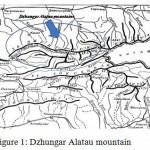 |
Figure 1: Dzhungar Alatau mountain
|
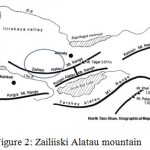 |
Figure 2: Zailiiski Alatau mountain
|
Chinese people have used as a purgative medicine, although some scientists consider it a medical enigma. During two years of trials at Palmer, Pantoja and Kuhl (2009) evaluated the effectiveness of 15 morphological characters for identifying cultivars and other clonal rhubarb specimens. Significant variability between the two years was reported for petiole epidermis color, petiole internal color, and the number of petioles per plant. The result suggest limited usefulness of these descriptors for identifying rhubarb accessions.13 The natural distribution of Rheum wittrockii Lundstr (Polygonaceae) is centered in two big different population on the adjacent areas Dzhongar Alatau mountain and Ili- Alatau mountain. At altitudes ranging from 1372 m to 1872 m was in these locations (Fig.1 and fig. 2).14
The aim of this research is conservation in ex situ of biodiversity of wild plant Rheum wittrock Lundstr in our flora of Kazakhstan. The Ili- Alatau is located at the very north edge of the Northern Tien -Shan. The North Tian -Shan consists of the following mountain ranges: Ili-Alatau, Kungei Alatau, Kyrgyz Alatau, and others. (Ile- Alatau, The Great Soviet Encyclopedia, 1969).15 The Northern Tian- Shan highest species diversity of flora is concentrated in the mountains. It’s related of feature of geografical location, altitude, orientation of the ridge, as well as soil and climatic condition of mountain areas.16
Materials and Methods
The researcher work was fulfilled of Institute of the Botany and Phytointroduction under the laboratory “Seed science and Plant protection”. The general germinability tests the seeds of Rheum wittrockii was collected two population in each a little gorge area of Rheum wittrockii are distributed in the north Tian-Shan and Zhungar Alatau. Solid circles indicate locations of the sampled population. Natural distribution of Rheum wittrockii Lundstr (Polygonaceae) is centered in two big different population on the adjacent areas Dzhongar Alatau mountain and Ili-Alatau mountain. The investigation work for seed germination tests was used methods development by Sildana Jaramillo and Margarita Baena Ex Situ Conservation of Plant Genetic Resources 2007. In basic seed generation test. In next process was used for generation of Rheum wittrockii. The seeds generation of Rheum wittrockii they differ in by generation process and by morphology. Seeds – three sided wide and narrow-winged nut. Seed protein, a central embryo.17 Before started the process were fulfilled process of complete sterilization of seeds.18 Then all seed of plant were 20 minute leave the in wet cotton material at 25oC temperature, and then 30 seed in each sample 10 piece in by three number of replications. Then Petri laboratory on wet filter paper at a temperature of 25-36o C then realize our researcher.
Result and Discussion
The important stage is the viability test (germination of seeds before their preservation). The device for the seed germination test ‘APS-2M‘(Jacobson’s table) fig 3-4. In each vegetable sample was used 10 seeds three number of replication, and one investigation area were 30 seeds number.
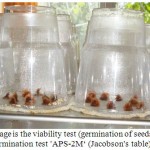 |
Figure 3: The important stage is the viability test (germination of seeds before their preservation) The device for the seed germination test ‘APS-2M‘ (Jacobson’s table)
|
Approximately one investigation plant population was used 90 seeds in total. In each variant plant sample seeds of 10 (spaced at least different) were sampled from each population, depending on accessibility and population size (Table1,2). The locations of the investigated population are listed in table 1 and table 2. Latitude and longitude, altitude were recorded for each natural little area of population or little gorge area using GIS unit (Garmin 60C).
Table 1: Rheum wittrockii population surveyed, germination of seeds (Pop№1)
|
No1 Population Zhungar Alatau |
Altitude (m) | Result | ||||
| Total seeds (piece) | grown | not germinated | ||||
| Р | % | Р | % | |||
| Matay gorge area | 1580 | 30 | 2 | 7 | 28 | 93 |
| Alyn-Emel gorge area | 1390 | 30 | 7 | 23 | 23 | 77 |
| Uzynbulak gorge area | 1490 | 30 | 3 | 10 | 27 | 90 |
Table 2: Rheum wittrockii population surveyed, with their seed germination parameters
|
No2 Population Zailiiski Alatau (north Tian-Shan) |
Altitude (m) | Result | ||||
| Total
seeds (piece) |
grown | not germinated | ||||
| Р | % | Р | % | |||
| Kotur bulak gorge area | 1372 | 30 | 12 | 40 | 18 | 60 |
| Kim Asar gorge area | 1438 | 30 | 5 | 17 | 25 | 83 |
| Turgen gorge area | 1872 | 30 | 8 | 27 | 22 | 73 |
After seeding in each plant seed germination test ‘APS-2M‘ (Jacobson’s table) continuation process. Then after 10- 14 days appearance new seedling by size 1,5 and 2cm (fig.5-6). In all sample they differ results about appearance a new seedling. The result of the germination of seeds in the important stage is the viability test (germination of seeds before their preservation).
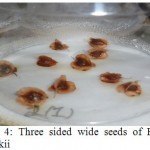 |
Figure 4: Three sided wide seeds of Rheum wittrockii
|
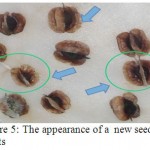 |
Figure 5: The appearance of a new seedling plants
|
The device for the seed germination test ‘APS-2M‘ (Jacobson’s table) fig.4 It gave us middle result. №1 Population Zhungar Alatau in first investigation area results were all seeds (piece) in each three number of replications results Rheum wittrockii first matay area grown seeds sample 7 % and not germinated 93 % very badly results. In Altyn-Emal gorge area grown Rh. wittrockii seeds 23% and 77 per cent in not germinated. In Uzynbulak gorge area grown Rh. wittrockii seeds 10% and 90 per cent in not germinated. Rheum wittrockii population surveyed, germination of seeds in Population Ili- Alatau (north Tian-Shan).
In by results of grown seeds of Rheum wittrockii in first gorge area 12 seeds given us results were total amount 40 % seeds germination. The result of the table number 2 very good results. Turgen gorge area total 30 seed on germination there were 8 seeds germinate and 27 per cent good seed germination. Seeds addition increased seed sample. The interference significantly increased seed germination in first Population Zhungar Alatau (table 1) with the decrease of the light of availability, but in total three gorge area seed germination 44 per cent of the seeds are germinated.
In next №2 Population Ili- Alatau (north Tian-Shan) here result increased to compare in first population, when to investigation the seed germination the result to increased 93 per cent showed. Therefore №2 Population Ili- Alatau (north Tian-Shan) here result increased especially Kotur bulak gorge area 40 per cent and Turgen gorge area 27 percent. The gorge area of Kim- Asar so not very decrease. In below figure phota about result Rh. wittrockii in showed general research in seed germination after successful result of seed germination (fig.6) of Rheum wittrockii. we were received adults plant and planting their of the nursery.
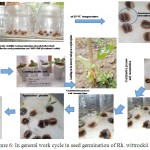 |
Figure 6: In general work cycle in seed germination of Rh. wittrockii
|
In general work cycle in seed germination of Rh. wittrockii in below picture full process about received adults plant. This research process it takes approximately 30-36 days. After appearing adults plant their planted nursery near research Institute for conservation in ex-situ in long time.
Conclusions
Our results indicate that the Rh. wittrockii very good combination of seed germination. According to the results of these figures calculation conformity study observed that the population Ili-Alatau (north Tian-Shan) by result increased seed germination the result to increased 93 % showed. The significantly increased seed germination in other population Zhungar Alatau with the decrease germination, but in total three gorge area seed germination 44 % of the seeds are germinated.
Rheum wittrockii population altitude surveyed, №1 population мatay gorge area -1580 altitude (m), alyn-Emel gorge area -1390 altitude (m), uzynbulak gorge area -1490 altitude (m). №2 population кotur bulak gorge area-1372 altitude (m), кim Asar gorge area-1438 altitude (m), тurgen gorge area-1872 altitude (m).
Rheum wittrockii good of seeds germination №1 Population мatay gorge area -7 %, alyn-emel gorge area -23 %, uzynbulak gorge area -10 %. №2 Population кotur bulak gorge area-40 %, кim asar gorge area-17%, тurgen gorge area-27 %.
Acknowledgments
Support for this researcher was provided by of Institute of the Botany and Phytointroduction under the laboratory “Seed science and Plant protection”, and al –Farabi Kazakh National University.
References
- Baytenov M. S. Flora Kazakhstan Genus complex of flora. ISBN9965-07-36-9. 2001;2:102.
- The Genera of Vascular Plants of Korea Series: Flora of Korea Edited By: Chong-Wook Park Nov | №171884 | ISBN-13: 9788976163806. 2007;359-360.
- Flora Kazakhstan. Alma-Ata Publishing Academy of Sciences of Kazakhstan. 1960;3:102.
- The Red Book of Kazakhstan. Part 2. Plants. – Institute of Botany and Phytointroduction. 2014:80.
- Ensconet Seed Collecting Manual for Wild Species. 2009.
- ISTA Handbook on Seedling Evaluation, 3rd Edition. 2013.
- Sildana Jaramillo and Margarita Baena Ex Situ Conservation of Plant Genetic Resources 2007.
- RSE. Institute of Botany and Phytointroduction CS MES of Republic Kazakhstan, Almaty. botsad.kz.
- Kokoreva I. I., Otradnykh I. G., Sedin I. A. Vladimir L Rare species of plants of the Northern Tien Shan (population, morphology, ontogenesis, resumed). Monography.- Almaty. 2013;208.
- Barney D and Hummer K. Rhubarb: Botany horticulture and genetic resources. Hort. Rev. 2012;40:147-182.
CrossRef - Yang Y. C. Tibetan Medicine. Qinghai People Press, Qinghai (China). 1991.
- Ile Alatau The Great Soviet Encyclopedia: Ch. Ed. Prokhorov. – 3rd Ed. – Moscow: Soviet Encyclopedia. 1969-1978.
- Pantoja A and Kuhl J. Morphologic variation in the USDA/ ARS rhubarb germaplasm collection. Plant Genet. Resour. 2009;8:35-41. Characterization Until.
- http://www.marshruty.ru/Places-6989-4//97.
- Ile Alatau // The Great Soviet Encyclopedia: // Ch. Ed. Prokhorov. – 3rd Ed. – Moscow: Soviet Encyclopedia. 1969-1978.
- Sitpayeva Gulnara Study and Preservation of Wild Relatives of Cultivated Plants of the Northern Tien Shan (Within Kazakhstan) International Conference Applied Ecology: Problems, Innovations. 2015;136.
- Botanical Society of Britain and Ireland. Archived from on 2015-02-25. Retrieved. 2014-10-17.
- Sildana Jaramillo and Margarita Baena Ex Situ Conservation of Plant Genetic Resources. 2007;322.

This work is licensed under a Creative Commons Attribution 4.0 International License.





